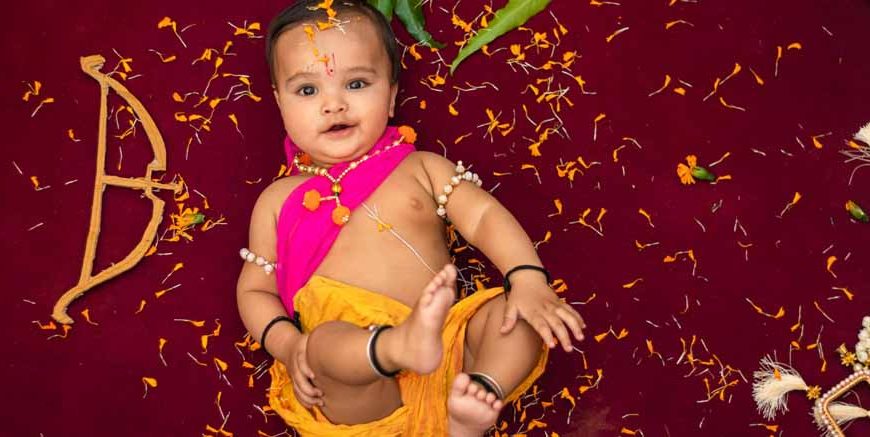The birth of a child is an event of immense joy and celebration for families, especially in India, where traditions and rituals are deeply embedded in our culture. Our traditions and customs reflect this joyousness. Among the most important rituals performed after childbirth is the Naamkaran ceremony which gives name to an infant. Naamkaran Ceremony (Naming Ceremony) is a beautiful and sacred rite that marks the official declaration of what will henceforth be known about someone’s identity and fate according to ancient Vedic tradition.
Now let’s talk about why this day should be made even more special with some exciting name-giving decoration ideas along with its significance and procedure.
What is Naamkaran Ceremony?
Naamkarann or naming ceremony, as traditionally followed in Hinduism across the Indian subcontinent where babies are given their names on the 11th day post-birth. However, depending upon astrological readings or other such factors families may choose different days also but this particular function holds great value among us all. The word ‘Naam’ means name while ‘Karan’ implies making so through this we can interpret it as creating/ giving a new identity.
It is considered very auspicious and meaningful because it has been believed since ancient times that the personality and future of any individual largely depend upon what he/she gets called by others; therefore right selection becomes necessary which could either bring success or failure into the life of that person concerned. Generally speaking, the name should be based upon the Nakshatra (birth star) of a child or sometimes priest helps find good ones aligning with favorable astrological combinations etcetera.
Rituals performed during Naamkaran Ceremony
Every ritual has its own importance attached to it; although they might change slightly from place to place within our country but mostly all remain the same at heart.
Puja & Havan: Before formally announcing the name, the family does prayers seeking blessings from the almighty through lighting a holy fire called havan where mantras are chanted by a priest for safeguarding against negative energies and ensuring good health, prosperity, and happiness in the future life of the baby.
Naming: Father or the priest whispers the selected name three times into the right ear of the child along with gently ringing a small bell to let the baby know what he/she shall be called thereafter; then it is publicly declared among a gathering composed of relatives and friends.
Aashirwad (Blessings): After telling everybody’s names aloud, elders put rice grains over their foreheads along with turmeric, flowers etc while praying for their wellness and also keeping them on the table where kids used to sleep during initial days as a gesture towards ancestors’ blessings continuing through generations.
Meaning behind Naamkaran Ceremony
Naming a child not only gives him/her an identity but also connects such a person with his/her roots, religion and divinity. According to Hinduism vibrations in a name can shape one’s fate so this function becomes an integral part of somebody’s life.
Moreover, apart from being a joyous occasion for parents, it acts as a binding force between different family members who come together during these sacred moments around newborn babies thereby strengthening relationship ties among kin groups within communities; furthermore serves as an introduction rite between child rest of world.
Making the Naming Ceremony Memorable: Naming ceremony decoration ideas
Among the most exciting parts of getting ready for a naamkaran ceremony is organizing the celebration. In Indian culture, no festivity is complete without lively decorations, and naming ceremony decoration is not an exception. Here are some ideas for naming ceremony decorations which can add enchantment and magic to your event:
Traditional Floral Backdrops:
Flowers are synonymous with Indian celebrations. A traditional floral backdrop made up of marigolds, roses or jasmine can act as a perfect setting for the baby’s cradle. Not only will it look beautiful but also denote purity, peace and prosperity.
Personalized Name Banners:
Create a special name banner that proudly displays the baby’s name somewhere around where people enter or exit from; this could be inside near doors leading into or out of the house/venue or outside hung up above the gate etc.. You may select pastel colors if you want everything to feel soft and calm otherwise go all out vibrant with strong contrasting shades that stand out against each other especially when placed in well-lit areas.
Cradle Decoration:
The cradle is the centerpiece of any naamkaran ceremony so consider decorating it accordingly using gentle cloth drapes tied back with ribbons along its sides while matching flowers should be scattered over them too so they blend seamlessly together throughout the whole setup area plus hanging fairy lights would give this place a magical touch..
Theme-Based Decor:
Choose a theme that reflects your family’s personality; for example, you could have celestial-themed decorations featuring stars & moon shapes etc., traditional Indian royal decorations complete with richly coloured fabrics draped over chairs etc., whimsical garden setups filled up with lots of greens alongside butterflies scattered here there etc.
Balloon Arches & Garlands:
Go modern by introducing balloon archways or garlands into space using light pastel tones such as a baby blue color scheme mixed in with other softer shades including soft pink or mint green. Balloons can add playfulness yet elegance especially when combined together evenly throughout the whole look alongside flowers..
Personalized Touches:
Incorporate personal touches such as framed photos showing newborns’ faces close up, name cards placed on table tops surrounding the main area where guests will be seated while chalkboard signs displaying babies’ birth details like time date star signs could also work well hanging above entrance/exit points so everyone gets to see them.
Without a doubt, these naming ceremony decoration tips will help create an amazing atmosphere for a day that shall forever remain etched in your family’s memory.
What Do You Wear To A Namkaran Ceremony?
As with any Indian function, dressing for a namkaran ceremony calls for both traditional attire and festive wear. If you are the child’s parents or close relatives it is expected of you to dress in something that reflects joyousness associated with this event.
Men can go for a classic kurta pyjama set or just a simple sherwani; women may choose sarees, lehengas or elegant salwar kameez suits all designed using celebratory colors like yellow, red, and green among others such as gold etc.. Even guests too should try going traditional provided they blend well within the overall ambience created by everything else around them during the entire occasion itself.
Conclusion
The Naamkaran is not just another meaningless ritual – far from it! It represents an ancient rite steeped in spirituality, happiness and cultural values which set the foundations for the child’s life journey ahead. As parents we owe our kids nothing less than making this function meaningful and memorable, everything else becomes secondary after that because what matters most is how much love did you show them during their special day when we were still starting out on earth.
Whether through carefully considered decorations for naming ceremonies or simply by wrapping them warm love-filled hugs; The Naam Karan will forever remain etched into hearts as one of those special events that changed everything for everyone involved, marking the beginning of a new chapter in life that’s meant to be shared forever.
EuroKids knows the significance of the beginning of a child’s life in terms of growth and development. Hence, we ensure that right from their initial years they are provided with a caring environment that also supports learning; an environment that nurtures their self-assurance as they begin this journey called life.
















